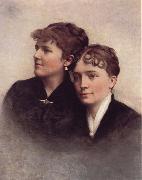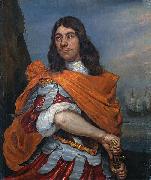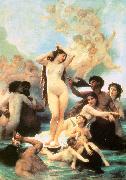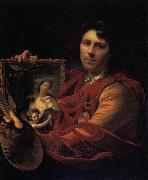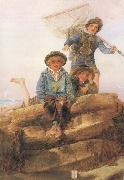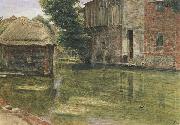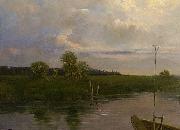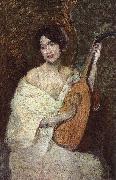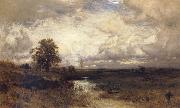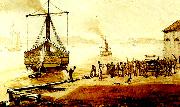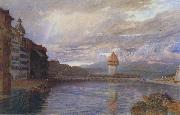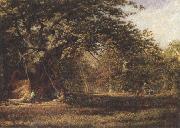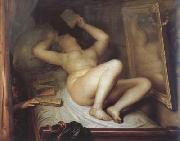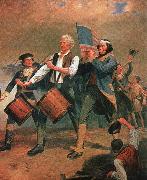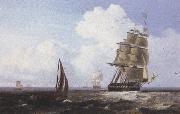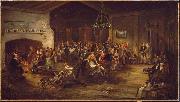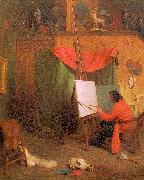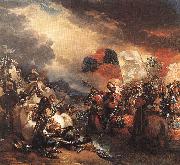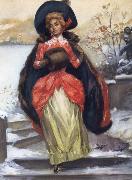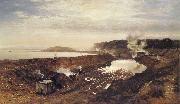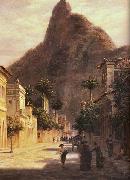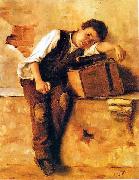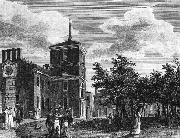|
|
|
|
|
|
|
|
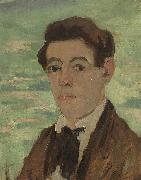 |
Abraham Walkowitz
|
|
(March 28, 1878 - January 27, 1965) was an American painter grouped in with early American Modernists working in the Modernist style.
Walkowitz was born in Siberia and emigrated with his mother to the United States in his early childhood. He studied at the National Academy of Design in New York City and the Academie Julian in Paris under Jean-Paul Laurence. Walkowitz and his contemporaries later gravitated around photographer Alfred Stieglitz's 291 Gallery, originally titled the Little Galleries of the Photo-Secession, where the forerunners of modern art in America gathered and where many European artists were first exhibited in the United States. During the 291 years, |
|
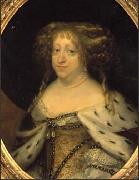 |
Abraham Wuchters
|
|
Abraham Wuchters (1608 - 23 May 1682) was a Dutch-Danish painter and engraver. He was born in Antwerp but had most of his career in Denmark where he, along with Karel van Mander III, was the preferred painter of the Danish King, nobility and Bourgeoisie during his day, together they represent the main influence from the Dutch Golden Age on Danish Baroque art.
Wuchters was born in Antwerp in 1608. He arrived in Denmark in 1638 and was, the following year, employed as sketching master at Sorø Academy. Around the same time, he was summoned to Copenhagen where he painted several portraits of King Christian IV. In 1645 he returned to Copenhagen Castle to portray the King's children, including lrik Christian Gyldenløve (c. 1645, Danish National Gallery) and Duke Frederik (III) (c. 1645, Amalienborg Palace).
In two periods, between 1658 and 1662, he worked at the Royal Swedish Court in Stockholm where he portrayed Queen Consort Christina (1660, Uppsala University and 1661, Stockholm Castle), Charles X Gustav and Hedvig Eleonora.
Back in Denmark, Wuchters was engaged by Frederick III, who had instituted Denmark as an absolute monarchy in 1660, with responsibility for the maintenance of his paintings.
n 1671 the new king, Christian V, appointed him as official Painter to the Danish Coirt and in 1873 he was also made official Engraver to the Danish Court. It was, therefore, he alone who decided how the face of the absolutist King was to be represented. |
|
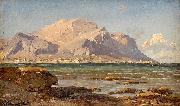 |
Adalbert Waagen
|
|
painted Bucht von Palermo mit Blick auf Monte Pellegrino in 1896 |
|
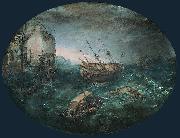 |
Adam Willaerts
|
|
(July 21, 1577, London - April 4, 1664, Utrecht ) was a Dutch Golden Age painter.
Willaerts (occasionally Willarts, Willers) was born in London to Flemish parents who had fled from Antwerp for religious reasons. By 1585 the family lived in Leiden. From 1597 until his death, Adam lived in Utrecht, where he became a member of the Guild of St. Luke in 1611, and subsequently rose to dean in 1620. His sons Cornelis, Abraham, and Isaac followed in his footsteps.
He was known as a painter of river and canal pieces, coastal landscapes, fish-markets, processions, and genre scenes. He also painted villages and marine battle scenes.
|
|
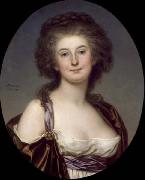 |
Adolf Ulrik Wertmuller
|
|
(February 18, 1751 e October 5, 1811) was a Swedish painter whose notable works include Danaë receiving Jupiter in a Shower of Gold.
Wertmeller was born in Stockholm and studied art at home before moving to Paris in 1772 to study under his cousin Alexander Roslin and French painter Joseph-Marie Vien. On July 30, 1784, Wertmeller was elected to the Royal Academy of Painting and Sculpture.
Wertmeller was commissioned by Gustav III of Sweden for a portrait of Marie Antoinette, which is now in the Nationalmuseum at Stockholm. In 1787, he produced his masterpiece Danaë, a work which proved controversial as one of the earliest female nude paintings exhibited in America.
Wertmeller first emigrated to the United States in May 1794 and continued his portrait work, most notably of General George Washington, but in 1796 was called back to Sweden, eventually returning to Philadelphia in 1800. Elizabeth B. Johnston, in her book Original Portraits of Washington (Boston, 1882), speaks of five portraits of Washington by Wertmeller, of which one, executed in 1797, was purchased by the U. S. government in 1878, and another is owned by the Historical Society of Pennsylvania.
Wertmeller was married to Elizabeth Henderson, granddaughter of noted early American painter Gustavus Hesselius, on January 8, 1801, and two years later retired to a plantation in Claymont, Delaware, where he lived the final years of his life. He died near Marcus Hook, Pennsylvania, aged 60.
|
|
|
|
|
|
 |
Aelst, Willem van
|
|
Dutch Baroque Era Painter, 1627-ca.1683
Studied under Otto Marseus van Schrieck.
Students included Rachel Ruysch.
Specializes in Still Life.
|
|
|
|
|
|
|
|
|
|
|
|
|
|
|
|
|
|
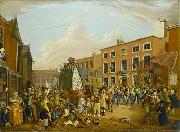 |
Alexander Wilson
|
|
Alexander Wilson (July 6, 1766 - August 23, 1813) was a Scottish-American poet, ornithologist, naturalist, and illustrator.
Wilson was born in Paisley, Scotland, the son of an illiterate distiller. In 1779 he was apprenticed as a weaver. His main interest at this time was in writing poetry (Robert Burns was seven years older than Wilson). Some of Wilson's work - commenting on the unfair treatment of the weavers by their employers - got him into trouble with the authorities. The "golden age of Renfrewshire song" is embodied in the persons of Wilson and Robert Tannahill. Alexander Wilson was born near the Hammils, a broad if not steep waterfall in Paisley where the River Cart skirts Seedhill. It does indeed appear to be the case, as William Motherwell states, that a great amount of literary activity began in Paisley around this time.
Illustration from
"An American ornithologyIn May 1794 Wilson left Scotland with his nephew to find a better life in America. Wilson obtained employment as a schoolteacher in Milestown, near Philadelphia. In 1801 he left Milestown and found a new teaching post in Gray's Ferry, Pennsylvania; Wilson took up residence in nearby Kingsessing. It was here that he met the famous naturalist William Bartram who developed Wilson's interest in ornithology. In 1802 Wilson decided to publish a book illustrating all the North American birds. With this in mind he traveled widely, watching and painting birds and collecting subscribers for his book. The result was the nine-volume American Ornithology (1808-1814), illustrating 268 species of birds, 26 of which had not previously been described. He died during the writing of the ninth volume, which was completed and published after his death by his friend George Ord. Wilson lies buried next to Ord at Gloria Dei Church cemetery in Philadelphia, Pennsylvania. |
|
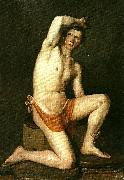 |
alexis wetterbergh
|
|
wetterberghs malning bar professor sandbergs godkannande paskrift, men eftersom maleri inte forekom pa konstakademiens schema fore 1856 |
|
|
|
|
|
|
|
|
|
|
|
|
|
|
|
|
|
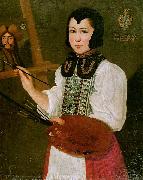 |
Anna Waser
|
|
Anna Waser (1678 - 1714) was a Swiss painter . |
|
|
|
|
|
|
|
|
|
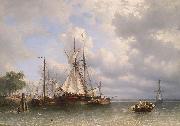 |
Antonie Waldorp
|
|
(The Hague, 28 March, 1803 - Amsterdam, 12 October, 1866) was a Dutch painter and a forerunner of the Hague School.
Anthonie Waldorp was the son of Abel de Saaijer Waldorp and Jacomina Godde, and the grandson of Jan Gerard Waldor, who was superintendent of the National Art Gallery. On February 25, 1824 he married Johanna Sophia Waldorp van Hove. At the wedding in The Hague there was a clerical error in the marital attachments, mistakenly registering Anthonie as Anthonie Waldorp instead of Saaijer Waldorp.
Shortly after his 23rd birthday, Anthonie decides to follow a career as a painter and became one of the precursors of the Hague School. Anthonie took an apprenticeship with the well known stage scenery painter Joannes Breckenheimer jr. (1772-1856) in The Hague, who was also the tutor of the well known painter Andreas Schelfhout.
Anthonie started painting stage sceneries like his grandfather. Later he focused on domestic and church interiors and portraits (people in 17th century costumes). Finally he specialized in landscapes, river and seascapes (paintings, drawings and water colors). It proved to be a wise decision as it led to international recognition. He also did some lithographic work. In 1833, together with Wijnand Nuyen, he traveled through France, Belgium and Germany and became the tutor of C.P. et Hoen, J.C. Hofman, C. Rochussen and Johan Hendrik Weissenbruch. Many of his paintings were bought by German, Dutch and French kings.
Until 1857 he lived in The Hague, after which he settled in Amsterdam where he joined the Royal Academy . He received several awards: in 1845 Waldorp was appointed Knight of the Order of Leopold by the Belgian king, Knight in the Order of the Dutch Lion in 1847 by King William II and Knight in the Order of the Oak Crown in 1849 by William.
In The Hague and Amsterdam there are streets named after Anthonie Waldorp.
|
|
|
|
|
|
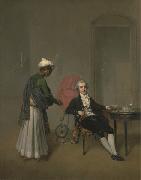 |
Arthur William Devis
|
|
(10 August 1762 - 11 February 1822) was an English painter of history paintings and portraits. He was appointed draughtsman in a voyage projected by the East India Company in 1783, under Captain Henry Wilson, in which he was wrecked on the Pelew Islands before proceeding to Canton and thence to Bengal. He painted portraits and historical subjects, sixty-five of which he exhibited (1779-1821) at the Royal Academy.
|
|
|
|
|
|
|
|
|
|
|
|
|
|
|
|
|
|
 |
Bessie Wheeler
|
|
Bessie Wheeler was a painter about whom little is known, other than that she was born in 1876. She painted portraits of people encountered on the streets of Honolulu around 1900. She contributed illustrations to Thrum's Hawaiian Annual and was a member of the Kilohana Art League. |
|
|
|
 |
Blake, William
|
|
William Blake was an English poet, painter was born November 28, 1757, in London |
|
 |
broderna von wrights
|
|
Dessa ornitologer, forskare, naturvetenskapliga illustratörer och konstnärer var födda i Haminanlaks nära Kuopio i Finland.
I Stockholm i augusti 1828 påbörjade Magnus och Wilhelm von Wright bildverket Svenska Foglar, finansierat av greve Nils Bonde. Detta ornitologiska verk blev klart 1838 och ar en en samling pa178 litografier.
|
|








